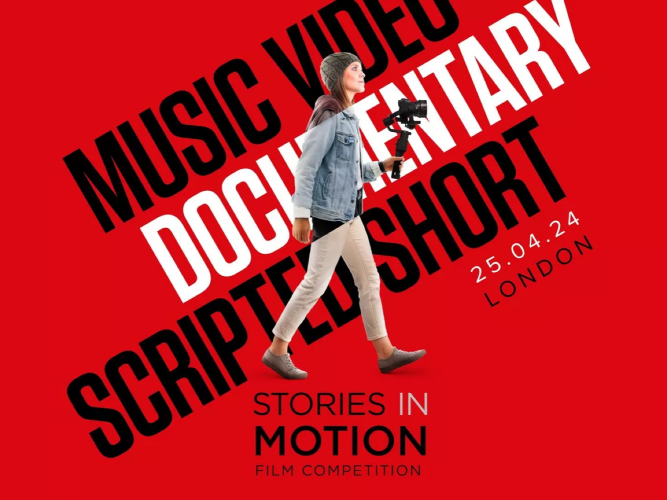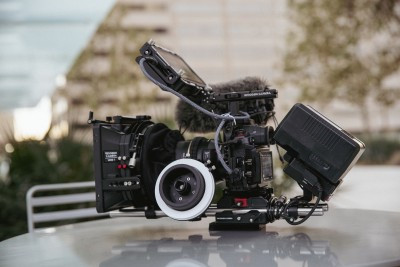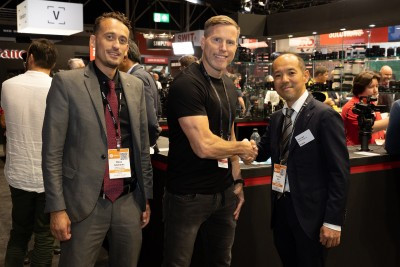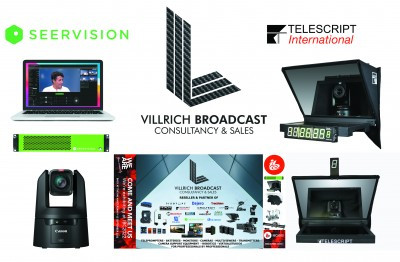A day in the life of a Royals videographer

Author: Bob Pank#
Published 1st May 2011
Times have changed; no more phone calls, telexes or faxes, - remember them? Now it’s E-mails; what would we do without them?
A quiet day in the office-come-edit-suite, the FCP rendering yet another set of archive clips, and the other Mac illuminated with Thunderbird, when ‘ping’ (the Mac version of “You got mail”) wakes one up from the hypnotic trance of admin.
Yes, an e-mail had dropped, not just any old e-mail; more a clarion call for a hectic 3-day drive and film – a one-man marathon around England, Wales and Scotland after a young couple who the nation, and the world, has taken to heart. Yes, Prince William and Kate Middleton were on the move; the story continues.
The e-mail was official confirmation that the Royal couple would name a lifeboat in Anglesey on the Thursday afternoon, and attend a function and walkabout in St. Andrews University in Scotland the next morning.
Life conspires to be helpful – sometimes – I had already done the same 400 mile trip in the middle of last year while working on a documentary about the couple, so without hesitation, deviation … I applied for the relevant passes and booked the same hotels I had used then. I then contacted my wife!
In the ensuing phone calls to various contacts, it came to light that the Royal twosome may well attend the wedding of a close friend just north of Newcastle. So an overnight stop with a friend in Leeds was on the cards. That was soon fixed.
The only downer was that I was refused a “Fixed Point Pass” for the Anglesey leg, but that was to be expected, as most of my stills photography colleagues had suffered the same fate. I was going to attend and film from the public area, as there was sure to be a walkabout down the road, and filming from a public place is common practice, and allowed at events like this.
Let battle commence.
The kit to load.
Two 2/3 inch cams (one DVCam one back-up DVCPro), one HDV camera, converters, tripod, ladder etc. 12v kettle, mugs, teabags, coffee, uht milk, and three days-worth of luggage. Oh and don’t forget the tapes.
Now I am ready to go.
I then got an unprecedented phone call, followed by an e-mail from the organisers late on Tuesday – warning against going to Wales, and the consequences if I did. I reluctantly took the decision to cancel my hotel room and abandon the Welsh leg of the trip.
There were two upsides to this. I would have a full day to get to Scotland and it would save about 150 miles and a hotel bill. Downside is would miss some fantastic footage.
After 600 miles, a nice meal, a night in a comfy bed in a very helpful hotel just outside Dundee and I was ready. At 0645 I was on the road to St. Andrews, where I arrived at 0715, so where was the expected traffic?
I was parked and it’s time to decide what kit to use.
In most cases I try and use the Canon HDV XH-A1 as it is quite manageable and gives me more options, especially in a walkabout situation; however the drawback is it only has a 20x lens with no option to double. But if I need the long lens option I have both DVCPro and DVCam Ikegamis with a Fujinon 20x with a built in doubler and an Optex (RIP) 2x converter giving me an 80x lens set up.
The drawback is the weight, and it is difficult to film from above shoulder height; also you really do need a tripod, which limits your flexibility.
I took the decision to acquire an HDV XH-A1 in the middle of last year. I was looking at a JVC body that would take my 2/3 inch lenses, but due to problems handling the files I was forced to look for a second-hand HDV to complete a commission, and the Canon gave me the best all-round spec with its 20x lens and better image stabilisation. It also has auto focusing, auto WB, auto exposure, which proves useful when shooting overhead and it uses tape, which makes archiving much easier for me. I had used a SD edition of the camera for many years with some good results.
I loaded both HDV and SD systems, tripod, monopod, 3 spare batteries, tapes and the ubiquitous aluminium ladder on my fishing trolley, and made my way to the fixed point in the middle of North Street to mark my spot with ladder and tripod.
My experience of past events showed that the North Street fixed point would be the most flexible, so there I stayed.
The crowds gathered and the TV crews turned up by the score. The live links were established, and I enjoyed a coffee courtesy of a friendly agency producer.
Time for the briefing we all had to attend. Well, it had free tea and oat biscuits, but we learned nothing that we hadn’t already gleaned from the press officers there.
Back to work and I opted for the Canon on a monopod.
Working from the top of the 4-step ladder modified for the monopod, the Canon gave me a superior height and flexibility as well as HD material. The DVCam was beside the tripod in-case it was needed.
Footage of Miss Catherine Middleton, soon-to-be royal bride, is like the teeth of the hen, so as soon as she appeared the mayhem started; with the snappers calling, the crowds cheering, and the mobile phones held aloft trying to get something of the lady in red. I had my camera on the monopod above the crowd level, although the snappers on their ladders still got in the way.
Kate was presented with the ubiquitous bouquet of flowers, but Prince William stood in the way. Mark this one up for the Princes Royal visit training manual.
The couple then split, and Kate took the side the press were on and shook hands with everyone she could.
With the Canon on the monopod, I got steady footage of her progressing along the crowd. With Kate at about 3/4 length in the viewfinder I decamped, grabbed the steps and moved past the cheering crowd to the next position. I was in time to get some exceptional shots of Kate passing in front of me and talking to children as she shook their hands.
I moved three times in the 15-minute walkabout, and finished with some remarkable footage. It was a bun fight and it was pandemonium, but was worth it.
The choice of the HDV was the right one, and the use of the monopod made sure that the footage was steady, even when taken from above head height. The auto settings came into their own, giving me 13 minutes of very useable footage.
Back at the car I prepared for phase 2 of the journey.
Having celebrated in Leeds over night and undertaken the drive back north, listening to an eclectic mix of music on the car’s iPlayer, I found myself outside the Harry Potter Hogwarts Castle in Alnwick in Northumberland, joining the press pack for the 5 o’clock wedding of the Duke of Northumberland’s daughter.
Again the HDV was the choice of camera, but the distance involved was borderline for the 20x lens and the thought that at 6pm the light would be very problematical weighed heavily against it, but its versatility and the HDV factor gave it the edge.
The expectation was for a Royal presence at the church, but no Royals appeared. However, the footage I obtained proved a very positive addition to the archive. The event was graced by Pippa Middleton (Kate’s sister), and Prince Harry’s girlfriend, Chelsy Davy. With the Royal Wedding on the way, any ‘official’ footage of Kate’s family is worthwhile.
The limitations of the Canon and its 1/3-inch chip were exposed, with bright sunlight reflecting off the sandstone wall and the subject in black, resulting in over exposure, but somehow I managed. In this situation the manual aspects of the Ikegami are far superior.
In a situation where you have a short time to grab what you can, finding and hitting the exposure override button is not normally an option, so one has to go with what one gets.
The wedding finished at 6pm, but the light was too low to get any more effective footage, so I decided to stick with what I already had, and head for home and my own bed.
The manifestation of YouTube has made my presentation to researchers much easier. I edited the footage of Pippa and had it on the site within hours of waking on Sunday, and it was closely followed by the footage of Kate and William. I don’t get millions of hits, but the right people see it.
As to the results: the kit stood up to the challenge, as did the cameraman, but please Canon and the other manufacturers do not assume that everyone needs wide angle lenses, some of us need a pro quality compact HDV type camera with a built-in doubler.
What of the future for the small agency supplying specialist footage to broadcasters and documentary makers?
The way that officialdom is going I don’t see much prospect for a very long-term future. The broadcasters don’t want to pay and copyright breaches mean that you are constantly looking over your shoulder. To add to the mix we are, in some circumstances, being asked to pay to do our job. This may suit the big boys but as a small freelancer it makes no financial sense. Gone are the heady days of the Diana era and the infamous Mike Lloyd and TV Papping.
A successful few days? Yes, but officialdom still came and spoiled the party.
The Anglesey fiasco will, I have no doubt, get sorted out, but look at the St. Andrews and Alnwick footage. The whole event is spoiled by: Yes fluorescent YELLOW jackets. Something I suspect that will NOT change.
-------------------------------------------
Richard Wintle is a partner in Calyx Photo and TV News Agency based in Swindon. Calyx started three decades ago and provided news photographs to the print media. In the late 90’s the focus changed when the television news industry went digital.
The Calyx TV Royal Archive grew from filming members of the Royal Family out and about in the Cotswolds and now supplies off-rota and exclusive accredited footage from Royal events at home and abroad.
































